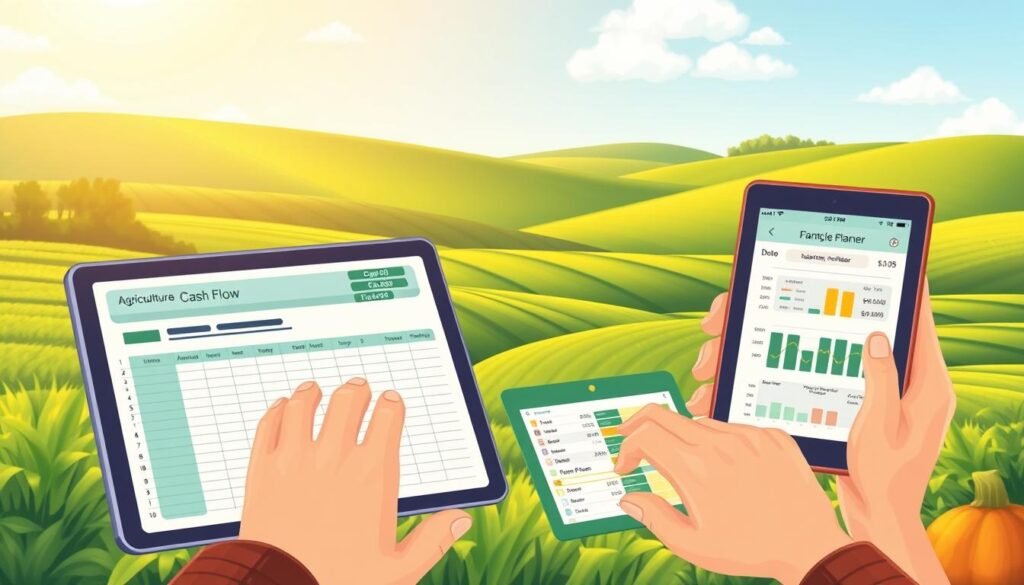Financial planning for agricultural businesses
Is your farm’s financial future as unpredictable as the weather it depends on? Financial planning for agricultural businesses is more than just spreadsheets. It’s a roadmap for turning uncertainty into growth. This guide will show you how to manage your farm’s finances to protect profits and grow your business.
Why do 68% of agribusinesses still face cash shortages, even with high yields? This article will explain how budgeting, technology, and SMART goals can help. Learn how diversifying into biofuels or value-added products can bring stability. Also, discover free tools like FINPACK analysis that reveal hidden opportunities.
Key Takeaways
- Effective cash flow forecasting reduces risks from weather and market volatility.
- Ag software like Levridge automates tracking, freeing time for strategic decisions.
- SMART goals clarify paths to profitability in grain processing or livestock ventures.
- Free FINPACK analysis from the Agricultural Credit School offers tailored business plans.
- Confidential financial reviews with farm-savvy advisors identify overlooked savings.
Understanding the Unique Financial Landscape of Agriculture
Managing money in farming needs special plans because of its unique problems. Things like income gaps, market changes, and weather risks need special help. This is where agricultural finance consulting and agricultural business budgeting come in. Let’s look at three main things that shape this world.
The Seasonal Nature of Agricultural Income
Harvest times bring in more money, but off-seasons have steady costs. Enterprise budgets from the Penn State Farm Management Handbook help keep track of money. Partial budgeting, taught online, helps farmers see how new ideas compare to old ones.
For example, a corn farmer might use this to figure out if new irrigation systems increase profits.
How Commodity Markets Impact Farm Finances
| Metric | 2024 | 2025 |
|---|---|---|
| Farm Income | $95B | $108B (+13.7%) |
| Credit Availability | $180B | $210B (+16.7%) |
| Risk Management Costs | $15B | $14B (-6.7%) |
Prices and global demand affect profits a lot. The 2025 forecast shows more credit, but price swings need careful planning. Farmers who watch USDA reports can stay ahead.
Weather-Related Financial Vulnerabilities
Droughts or storms can wipe out profits fast. The FarmSense workshop teaches how weather affects money. With risk costs falling 6.7% in 2025, agricultural finance consulting helps farmers use savings wisely.
Planning ahead, like setting aside for disasters, makes uncertainty easier to handle.
Why Traditional Financial Planning Falls Short for Farmers
Financial success in agriculture needs more than just general advice. Traditional methods often miss the unique rhythms of farming. For example, cash flow models for office jobs don’t fit farming’s planting-to-harvest cycles.
Farmers face challenges like equipment depreciation that doesn’t match standard accounting rules. This leaves gaps in their planning.
- Seasonal income gaps unaddressed by steady revenue assumptions
- Inadequate tools for tracking commodity price swings
- No focus on weather-driven emergencies
| Aspect | Traditional Approach | Strategic Approach |
|---|---|---|
| Cash Flow Modeling | Monthly projections | Seasonal forecasting |
| Risk Management | Basic insurance | Commodity hedging + disaster funds |
| Record-Keeping | Basic ledgers | Automated ag-specific software |
| Regulatory Knowledge | General compliance | Farm bill expertise |
AgAmerica’s clients saw 30% better liquidity after adopting agricultural wealth management. Farmers using one-size-fits-all plans often miss key factors. These include crop insurance gaps or machinery lifecycle costs.
Strategic financial planning for farming operations needs tools that reflect farming’s realities. It’s not about using spreadsheets made for retail businesses. Next steps include assessing your current practices to close these critical gaps.
Assessing Your Current Agricultural Financial Health
Creating a strong financial plan starts with understanding your numbers. Begin by reviewing key financial documents: balance sheets, income statements, and cash flow statements. These tools show your farm’s financial health, helping you make better choices. Let’s explore how to measure your financial standing.
Conducting a Farm Asset Inventory
First, list all your farm’s assets. Include land, equipment, livestock, and stored crops and their current market values. This helps you know what you own versus what you lease. Use spreadsheets or farm management software to keep track of changes.
Evaluating Debt-to-Asset Ratios
Calculate your debt-to-asset ratio by dividing total liabilities by total assets. A ratio under 0.75 means you have strong equity. Compare it to industry standards:
- Debt-to-equity ratio: total liabilities ÷ total equity
- Current ratio: current assets ÷ current liabilities (aim for ≥1.5 for stability)
Strive for ratios that match your farm’s size and goals. High debt-to-asset ratios may indicate too much debt.
Analyzing Cash Flow Patterns
Monitor cash flow trends using past data. FINBIN 2021 reports show working capital averages:
- $39,889 for farms under $100k revenue
- $636,000 for farms over $1M
Do you see seasonal cash flow dips? Plan for reserves during these times. Good farm financial management means spotting cash flow gaps early.
Creating a Robust Agricultural Business Budget
Agricultural business budgeting is key for financial planning for agricultural businesses. Start by listing fixed costs like land payments and variable expenses like seeds. Use past data to predict income and watch cash flow changes.
Forecasting Seasonal Expenses
Seasonal costs like planting supplies and harvest labor need careful tracking. Make a list of costs by quarter and add extra for price changes. For example, add 10-15% to the fertilizer budget if prices go up.
Tools like enterprise budgets help farmers compare the profit of crops or livestock.
Equipment Maintenance and Replacement
Plan for equipment costs over 5-10 years. Set aside money for repairs and think about refinancing loans to save cash. A 2023 USDA report shows farms with maintenance budgets cut downtime by 30%.
Incorporating Land Management Costs
Include costs for soil testing, irrigation upgrades, and conservation in budgets. A 2024 Purdue study found farms spending 8% of revenue on land health saw a 15% yield increase. Set aside money for drainage projects and cover crops to protect long-term productivity.
Update budgets regularly with tools like QuickBooks Farm or AgBudget. Small changes now can prevent cash problems later. This helps farms succeed through market changes and weather challenges.
Financial Planning for Agricultural Businesses: Core Strategies
Effective strategic financial planning for farming operations begins with SMART goals. These goals are specific, measurable, achievable, relevant, and time-bound. This helps farmers align personal and business goals, ensuring everyone is on the same page.
Start with a two-phase approach: Phase 1: Factor Analysis identifies personal and business goals. It also analyzes internal and external factors like market trends and operational strengths. Phase 2: Strategy Analysis turns insights into actionable plans, balancing growth with risk management. Tools like Farmonaut make tracking expenses and cash flow easier. Agricultural finance consulting experts can help with complex decisions.
- Comprehensive Cash Flow Budgets: Track monthly income/expenses to anticipate gaps.
- Expense Optimization: Use tech tools to reduce costs on inputs like seeds or energy.
- Strategic Borrowing: Align loans with seasonal cash flow cycles.
- Risk Mitigation: Diversify crops and use hedging to counter market swings.
Regularly review financial health metrics, like debt-to-asset ratios, to stay on track. By using technology and professional advice, farmers can face challenges like weather, market changes, and operational issues. Financial planning is an ongoing process that adapts to your farm’s growth and the changing agricultural world.
Developing Effective Cash Flow Management Systems
Effective farm financial management means using cash flow to your advantage. With seasonal income changes and unexpected costs, you need a solid plan. Start by tracking where money comes in and goes out.
An annual cash flow plan, like J&J Dairy Farms uses, helps predict income highs and lows.

Handling Seasonal Revenue Fluctuations
- Spread revenue streams with off-season crops or agritourism to stabilize income
- Use futures contracts (like J&J Dairy’s milk price locking) to secure prices
- Time harvests to align with market demand peaks
Creating Reserve Funds
S&S Grain LLC saved 10-15% of profits for emergencies. Keep these funds separate to cover unexpected costs. Don’t use them for regular expenses.
Tools for Tracking Expenses
- Digital platforms like QuickBooks or FarmOS automate expense logging
- Monthly expense reviews highlight areas to cut costs or reallocate funds
- Use spreadsheets to compare actual vs projected cash flow weekly
Regular agribusiness financial analysis helps adjust budgets. Farmers who compare themselves to industry averages face 20% fewer cash shortages. Start with a 3-month cash flow projection today.
Tax Planning Strategies for Farm Operations
Smart tax planning can save a lot for farm businesses. Agricultural finance consulting experts suggest prepaying for seeds and fertilizers to get deductions. Also, deferring income by storing grains can lower taxes now. Buying equipment before the year ends helps claim more depreciation.
- Use Schedule J to average income over three years, smoothing out profits.
- Pay qualifying children under 18 to shift income into lower tax brackets.
- Maximize retirement contributions: $6,000 ($7,000 for age 50+) in SEP or solo 401(k) plans.
| Strategy | Action | Benefit |
|---|---|---|
| Equipment Deductions | Buy machinery by December 31 | Claim full-year depreciation |
| Income Timing | Defer crop sales | Spread tax liability over years |
| Family Labor | Pay qualified dependents | Reduce household tax burden |
Conservation practices like cover cropping can get Section 179 deductions. Keep detailed records of all farm income, including government payments and grants. Agricultural wealth management experts can help with estate planning using valuation discounts. The Farm Service Agency (FSA) offers programs that fit with tax-optimized financing. Working with specialists ensures you follow IRS rules and maximize deductions.
Navigating Agricultural Loans and Financing Options
Getting the right loans is key for financial planning for agricultural businesses. Farmers have special needs, like seasonal costs and new equipment. Let’s look at options that help your farm grow and stay stable.
USDA Farm Loan Programs
The USDA’s Farm Service Agency (FSA) has great programs:
- Farm Ownership Loans: Up to $600,000 for land. Interest rates start at 1.5% for joint financing.
- Operating Loans: Up to $400,000 for daily costs like seeds and labor. Direct loans at 4.5% interest.
- Microloans: For small farms, with up to $50,000 and easy applications.
Working with Agricultural Credit Associations
Ag credit associations, like Farm Credit Services, focus on farm financial management. They:
- Offer flexible terms for farming cycles
- Know a lot about crops and livestock
- May let you borrow with lower down payments
Alternative Financing for Farm Expansion
Look at other financing options:
- Equipment leasing for things like tractors or harvesters
- Crowdfunding sites like AgFunder for unique projects
- State programs like Nebraska’s Beginning Farmer Tax Credit, offering lease support and tax breaks
Whether you’re starting a vineyard or growing your irrigation, pick what fits your budget. Always compare loan terms, interest rates, and repayment plans to avoid too much debt.
Strategic Financial Planning for Farm Diversification
Expanding revenue streams is crucial for resilient agricultural businesses. Strategic financial planning for farming operations involves looking into new ventures that fit with what you already have. Start by researching markets for specialty crops or organic produce to find gaps.
Assessing New Revenue Stream Opportunities
- Explore agritourism options like farm tours or farm stays to attract visitors.
- Invest in value-added products such as jams, baked goods, or meat processing to command higher prices.
- Use agricultural business budgeting tools to estimate startup costs and project returns for each option.
Budgeting for Diversification Projects
Start with a baseline budget to track fixed costs like land and labor. Add line items for new ventures, including unexpected expenses like equipment upgrades or marketing campaigns. USDA programs like the Value-Added Producer Grants can fund feasibility studies.
Managing Transition Periods Financially
Phased implementation spreads risk. Start small with pilot projects before going full-scale. Keep emergency reserves equal to 6–12 months of expenses during transitions. Avoid common mistakes like:
- Launching multiple projects simultaneously without testing demand.
- Ignoring market saturation in niche products.
- Overlooking licensing requirements for new activities.
Insurance as a Financial Planning Tool for Farmers
Insurance is more than just a cost. It’s a smart way to protect your farm and financial goals. For farmers, crop insurance for farmers and agricultural risk management through special policies can help manage risks. First, think about risks like weather, market changes, or equipment breakdowns.
- Crop insurance for farmers covers losses from disasters like droughts or floods.
- Livestock policies address disease outbreaks or mortality events.
- Liability insurance shields against lawsuits from accidents on farm property.
- Equipment insurance replaces machinery after theft or damage.
Link insurance with long-term goals. Whole life insurance can grow cash value for retirement, while term policies offer short-term protection. Irrevocable Life Insurance Trusts (ILITs) help avoid estate taxes, keeping assets for heirs. Farmers often mix federal programs like USDA crop insurance with private options for full coverage.
- Review policies annually to match evolving farm operations.
- Work with agents specializing in agriculture to avoid gaps in coverage.
- Use life insurance proceeds to pay debts, fund buyouts, or support non-farming heirs without selling land.
Insurance isn’t a one-size-fits-all solution. Customize coverage to fit your unique risks and financial goals. A term policy might be right for young farmers, while second-to-die policies are good for couples or partners. By adding insurance to your financial plans, farmers can protect years of hard work.
Retirement and Succession Planning for Agricultural Operations
Planning for retirement and farm ownership transfer needs careful agricultural wealth management. This protects both family and business interests. Many farmers put off these talks, but early planning makes transitions smoother. Start by building retirement income outside the farm, like rental properties or mineral rights.
When preparing heirs, focus on education and hands-on experience. Consider these steps:
- Assign phased responsibilities to train successors in management and financial decisions
- Use gifting strategies like annual $15,000 gifts per heir to ease future transfers
- Consult professionals to structure trusts or buy-sell agreements for fairness
Tax-efficient transfers depend on understanding estate limits. The 2023 federal exemptions ($12.9M per individual, $25.8M per couple) allow strategic planning. Options like life insurance can help compensate non-farming heirs while keeping operations intact. Documenting asset valuations and legal agreements prevents disputes over land, equipment, and livestock.
Effective financial planning for agricultural businesses includes open family discussions about roles and expectations. Work with a team of CPAs, attorneys, and financial advisors to address risks like cash flow gaps or unexpected health issues. Proactive steps now safeguard both your legacy and future generations.
Working with Agricultural Financial Specialists
When dealing with tough financial choices, teaming up with agricultural finance consulting experts can open doors. They focus on agribusiness financial analysis, creating plans for better cash flow, risk handling, and growth. Let’s see how they help:
- Expertise in farm-specific challenges: They know all about USDA rules and crop price changes.
- Data-driven decisions: They use tools like SWOT analysis to find cost savings and new income sources.
- Risk mitigation: They help with loan setups, interest rate management, and disaster planning.
| Service | Benefit |
|---|---|
| Cash flow modeling | Predicts seasonal revenue gaps |
| Equipment financing | Optimizes machinery purchase timing |
| Succession planning | Ensures smooth generational transitions |
| Profitability analysis | Identifies underperforming crops or livestock |
Look for advisors like Thomas Eatherly, a certified farm business management specialist. He helped Carl’s Custom Crop Scouting boost margins by 15% with cost reviews. Ask potential consultants:
- Do you use agribusiness financial analysis to track input costs?
- Can you benchmark my performance against regional averages?
- How do you integrate USDA program opportunities?
Services from firms like Beyond offer custom agricultural finance consulting for equipment, crop insurance, and green initiatives. Expert advice doesn’t replace your choices but enhances them. Begin by pinpointing financial areas that puzzle you, then find a partner that matches your vision.
Leveraging Technology for Better Farm Financial Management
Modern technology changes farm financial management by making data and decisions easier. Tools like AI and mobile apps offer solutions for agribusiness. They help with budgeting, forecasting, and analyzing data in real time.
Farm Accounting Software Solutions
Software like AgriSolutions or FieldBook helps with budgeting and tracking costs. It works with mobile apps for quick updates and fewer mistakes. It also predicts yields and costs with AI and climate forecasts.
These systems grow with your farm without getting too complicated. They use GPS to save resources and follow rules.
Digital Tools for Market Monitoring
Tools like CommodityWatch or MarketTrends Pro watch commodity prices and costs. They show trends on dashboards to help with pricing and controlling costs. These tools connect to financial software for smooth data flow.
Apps for Real-Time Financial Decisions
Apps like FieldExpense or AgriPlan track expenses and supplies in real time. AI gives insights on saving costs and staying compliant. Farmers can quickly compare inputs and outputs to make better decisions.
Creating a Financial Contingency Plan for Agricultural Crises
Farmers often face unexpected challenges like storms, price drops, or equipment failures. A solid agricultural risk management plan helps protect farms from these setbacks. Begin by making a list of potential risks, such as crop disease, market changes, or health emergencies.
Then, rank these risks based on how likely they are and how big the impact could be. This helps focus efforts where they are most needed.
- Build an emergency fund covering 20-30% of annual expenses using high-yield accounts.
- Automate savings during profitable seasons to grow reserves steadily.
- Use strategic financial planning for farming operations to diversify income through agritourism or livestock sales.
- Explore FSA guaranteed loans or USDA marketing loans for liquidity during crises.
Combine cash reserves with crop insurance, health coverage, and machinery warranties. Keep a list of emergency contacts, like the Farm Service Agency and advisors. Train staff on backup plans and document key tasks.
Tools like FarmRaise software help track finances in real time. Penn State Extension offers free risk assessment checklists.
- Renegotiate leases to lower costs during downturns.
- Jointly own equipment with neighboring farms to cut fixed expenses.
- Review plans quarterly and adjust for new risks like climate changes or supply chain delays.
Proactive planning can reduce stress during crises. Replenish funds after using reserves, and consider tax-smart asset sales with professional advice. A well-designed contingency plan can turn unexpected events into manageable challenges, not disasters.
Conclusion: Building Financial Resilience for Long-Term Agricultural Success
Financial planning for farms is key to staying strong in changing markets. By growing different crops and raising various animals, farmers can lower their risks. Crop insurance also helps protect against bad weather or price drops.
Using technology to manage money and operations is smart. Programs from the USDA, like crop insurance and subsidies, offer big help. Keeping your financial plans up to date with lenders and advisors is also important.
Planning for the future of your farm is crucial. This includes both the legal and emotional sides to keep the family together. Talking openly with banks and having clear documents helps build trust. This trust is important for getting loans and grants when you need them.
Building financial strength means always looking for ways to improve. By focusing on managing risks, using technology, and setting long-term goals, farms can do well even when things get tough. Starting these efforts now helps farms grow strong and leave a lasting legacy.
Source Links
- Financial Planning and Strategy for Achieving Long-term Agribusiness Goals – Beyond – https://beyond.biz/financial-planning-and-strategy-for-achieving-long-term-agribusiness-goals/
- Financial Planning for Successful Diversified Agribusinesses – https://thefarminginsider.com/financial-planning-agribusiness/
- Farm Financial Planning Program • Iowa State University – https://www.extension.iastate.edu/farmanalysis/
- Agribusiness Financial Management | Penn State Extension – https://extension.psu.edu/business-and-operations/business-management/financial-management
- Boosting Farm Financial Performance: Key Strategies for Agricultural Economic Growth in 2025 – – https://farmonaut.com/usa/boosting-farm-financial-performance-key-strategies-for-agricultural-economic-growth-in-2025/
- The value of financial knowledge in the farming landscape for small holder farmers. – https://www.linkedin.com/pulse/value-financial-knowledge-farming-landscape-small-rehlotse-vnwvf
- Farrm Financial Strategies for Landowners | AgAmerica – https://agamerica.com/blog/farm-financial-strategies/
- Financial Risk Management & Contingency Planning – Center for Commercial Agriculture – https://ag.purdue.edu/commercialag/home/resource/2023/03/financial-risk-management-contingency-planning/
- Understanding the Farm’s Financial Health: Basic Components to a Successful Business – https://www.canr.msu.edu/resources/understanding-the-farm-s-financial-health-basic-components-to-a-successful-business
- Assessing your farm’s financial health using your balance sheet – Farm and Dairy – https://www.farmanddairy.com/columns/assessing-your-farms-financial-health-using-your-balance-sheet/755540.html
- Five questions to assess the financial health of your farm – https://www.mnp.ca/en/insights/directory/five-questions-to-assess-farm-financial-health
- Strategies in Financial Planning for Farmers to Reduce Business Debt – Business Debt Adjusters – https://businessdebtadjusters.com/fishing-agriculture/strategies-in-financial-planning-for-farmers-to-reduce-business-debt/
- Tips for Successful budgeting in farm management – https://agrierp.com/blog/budgeting-in-farm-management/
- Budgets: Their Use in Farm Management – Oklahoma State University – https://extension.okstate.edu/fact-sheets/budgets-their-use-in-farm-management.html
- No title found – https://www.extension.iastate.edu/agdm/wholefarm/html/c6-41.html
- Mastering Farm Cash Flow: 10 Proven Strategies for Financial Success and Sustainable Growth – – https://farmonaut.com/precision-farming/mastering-farm-cash-flow-10-proven-strategies-for-financial-success-and-sustainable-growth/
- The Vital Role of Financial Planning for Farmers – https://bantuconsulting.com/the-vital-role-of-financial-planning-for-farmers/
- Developing a Cash Flow Plan – Oklahoma State University – https://extension.okstate.edu/fact-sheets/developing-a-cash-flow-plan.html
- Cash flow budgeting – https://farms.extension.wisc.edu/articles/cash-flow-budgeting/
- Farm Tax & Financial Planning Strategies for 2022 – Simon Lever – https://www.simonlever.com/farm-tax-financial-planning-strategies-for-2022/
- 11 Farm Tax Tips: Tax Strategies for U.S. Farmers in 2025 – https://www.localline.co/blog/farm-tax-tips
- An Introduction to Farm Loans: What You Need to Know about Farm Loans – https://www.capitalfarmcredit.com/blog-detail/blog/2024/02/05/an-introduction-to-farm-loans-what-you-need-to-know-about-farm-loans
- Farm Loans for Farmers and Ranchers – https://www.farmers.gov/loans
- Understanding the Different Funding Programs for Farmers | Lutz – https://www.lutz.us/blog/understanding-different-funding-programs-for-farmers
- Cultivating Prosperity: Financial Planning Strategies for Ohio Farmers and Agribusinesses – https://resoluteadvisor.com/cultivating-prosperity-financial-planning-strategies-for-ohio-farmers-and-agribusinesses/
- Financial Strategies for Farmers: Planning for a Stable and Successful Year – https://www.lakeridge.bank/blog/financial-strategies-for-farmers–planning-for-a-stable-and-successful-year
- Diversifying Your Farm with Confidence – https://www.fcma.com/community/insights/diversifying-your-farm-with-confidence
- Don’t Bet the Farm: The Role of Life Insurance – https://futurefarmermag.com/dont-bet-the-farm-the-role-of-life-insurance/
- Life Insurance in Farm Transition Planning – Part 2 – https://farmoffice.osu.edu/blog/thu-08222024-143pm/life-insurance-farm-transition-planning-–-part-2
- The Basics for Farm Succession Planning – Nationwide – https://www.nationwide.com/lc/resources/farm-and-agribusiness/articles/farm-succession-planning
- Farm Succession Planning: Your Complete Guide | Farm Bureau Financial Services – https://www.fbfs.com/learning-center/what-you-need-to-know-about-farm-succession-planning
- The Vital Role of Succession Planning for Farming Operations – Cornerstone Bank – https://www.cornerstone.bank/the-vital-role-of-succession-planning-for-farming-operations/
- Agribusiness Planning: Providing Direction for Agricultural Firms – https://extension.psu.edu/agribusiness-planning-providing-direction-for-agricultural-firms
- Preparing Agricultural Financial Statements – https://agwestfc.com/education-and-resources/financial-tools/preparing-financial-statements/preparing-agricultural-financial-statements
- Farm Business Consultants | Financial Business Consulting | Pinion Global – https://www.pinionglobal.com/services/farm-business-management/
- Why Farm Management Software Is Streamlining Modern Farming Operations – https://www.illinoisbank.com/resources/blog-post/why-farm-management-software-streamlining-modern-farming-operations
- How SAP Farm Management Transforms Modern Farming Practices – https://www.suretysystems.com/insights/how-sap-farm-management-transforms-modern-farming-practices/
- No title found – https://www.extension.iastate.edu/agdm/wholefarm/html/c3-58.html
- Emergency Fund Strategies for Farmers: Preparing for the Unexpected – https://www.farmraise.com/blog/emergency-fund-strategies-for-farmers-preparing-for-the-unexpected
- Contingency Plans for Dairy Farms: A Tool in a Crisis – https://extension.psu.edu/contingency-plans-for-dairy-farms-a-tool-in-a-crisis
- Agri Financial Planning: 2024 Tactics – https://thefarminginsider.com/agri-financial-planning-tactics/
- strong financial relationships – https://www.thebullvine.com/tag/strong-financial-relationships/








